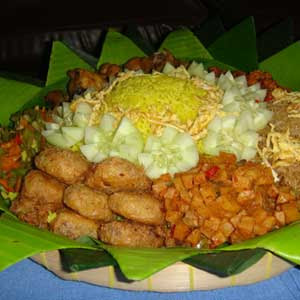Indonesian cuisine reflects the vast variety created by the people who live on the 6,000 populated islands that make up the modern nation of Indonesia. There is not a single "Indonesian" cuisine, but rather, a diversity of regional cuisines formed by local Indonesian cultures and foreign influences. Indonesian cuisine reflects its complex cultural history. Cooking varies greatly by region and combines many different influences.[1]
Throughout its history, Indonesia has been involved in trade due to its location and natural resources. Additionally, Indonesia’s indigenous techniques and ingredients were influenced by India, the Middle East, China, and finally Europe. Spanish and Portuguese traders brought New World produce even before the Dutch came to colonize most of the archipelago. The Indonesian island of Maluku, which is famed as "the Spice Island", also contributed to the introduction of native spices, such as cloves and nutmeg, to Indonesian and global cuisine.
Sumatran cuisine, for example, often shows Middle Eastern and Indian influences, featuring curried meat and vegetables, while Javanese cuisine is rather more indigenously developed. The cuisines of Eastern Indonesia are similar to Polynesian and Melanesian cuisine. Elements of Chinese cuisine can be seen in Indonesian cuisine: items such as bakmi (noodles), bakso (meat balls), and lumpia have been completely assimilated.
The most popular dishes that originated in Indonesia are now common across much of Southeast Asia. Popular Indonesian dishes such as satay, beef rendang, and sambal are also favored in Malaysia and Singapore. Soy-based dishes, such as variations of tofu (tahu) and tempe, are also very popular. Tempe is regarded as a Javanese invention, a local adaptation of soy-based food fermentation and production. Another soy-based fermented food is oncom, similar to tempe but created by different fungi and particularly popular in West Java.
Indonesian meals are commonly eaten with the combination of a spoon in the right hand and fork in the left hand, although in many parts of the country (such as West Java and West Sumatra) it is also common to eat with one's hands. In restaurants or households that commonly use bare hands to eat, like in seafood foodstalls, traditional Sundanese and Minangkabau restaurants, or East Javanese pecel lele (fried catfish with sambal) and ayam goreng (fried chicken) foodstalls, they usually serve kobokan, a bowl of tap water with a slice of lime in it to give a fresh scent. This bowl of water with lime in it should not to be consumed, however; it is used to wash one's hand before and after eating. Eating with chopsticks is generally only found in foodstalls or restaurants serving Indonesian adaptations of Chinese cuisine, such as bakmie or mie ayam (chicken noodle) with pangsit (wonton), mie goreng (fried noodle), and kwetiau goreng (fried flat rice noodles).







